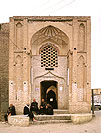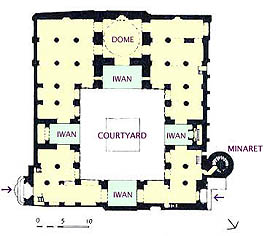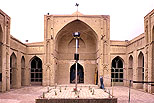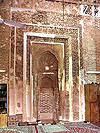|
FRIDAY MOSQUE
|
TAKEO KAMIYA
|
FRIDAY MOSQUE
|
TAKEO KAMIYA
|
Islam, born in Arabia in the 7th century, expanded rapidly throughout the Middle East, and furthermore extended its influence from Spain in the west to Central Asia in the east. The style of the mosques erected in each place in that early stage was the 'Arabic type' that was modeled after Muhammad's house in Madina. It is a building of simple principle, a continuous hypostyle hall with a flat roof that encircles a courtyard, and its Qibla wall facing Makka has a 'Mihrab' and a 'Minbar.' It is Persia (current Iran) that developed a new 'mosque-type' and spread it across the Islamic world in opposition to the Arabic type. Persia also was subjugated by the Islamic Empire from early on and was ruled from Baghdad, the capital of the Abbasid dynasty. However, Persians had pride in their history of the great empires of the Achaemenids before the Common Era and the Sassanids after that, inheriting higher culture and traditions from them than Arabia did from its predecessor.

As the Abbasid dynasty was weakening, owing to the increasing difficulty to control the whole Islamic area that had grown too vast, the rebirth of ancient civilization, that is to say 'Persian Renaissance,' became gradually conspicuous from the 10th century.
In Arabia, even though walls were built in masonry, roofs were principally built of wood to make them flat, while in Persian deserts they had developed the method of earthen buildings since before the Common Era, that is, the techniques of piling sun-dried bricks in an arch or baked bricks radially, laying the arches continuously in a barrel vault, and a dome in the shape of a globe cut into two. As they had been used to build an earthen dome on a Zoroastrian shrine, they came to be used in front of the Mihrab in mosques too. 
And furthermore, the architectural element that came to change dramatically the periphery of a mosque courtyard was the 'Iwan,' which is a half-exterior space used as a throne room or an audience room in the palaces of ancient Persia. This symbolic space under a large arch bordered by a square frame, preceding a half dome or barrel-vaulted ceiling, was not only a comfortable space giving a cool shade but also an expression of the regal authority.
It seems that the flat shaped mosque of the Arabic type was too monotonous for Persians; they wanted to give religious symbolism to the courtyard that was the nucleus of a mosque, inserting an Iwan into the center of each arcade encircling the courtyard to make it articulated and picturesque.

One of the still existing typical four-iwan mosques at the incipient stage is the Friday Mosque in Zavareh, an oasis city in the Kavir Desert. A mosque, in which lots of town inhabitants congregate for worship of God every Friday, is referred to as the 'Masjid-i-Jami' (Friday Mosque). Zavareh is a small city, so that the Friday Mosque too is as small as the size of its courtyard that is 16m square. Since four Iwans face each other across this courtyard (the width of each which is about one third of the length of each side), this generates a thoroughly different, dynamic impression from a monotonous Arabic type mosque. Here, a new mosque-type was definitely born, surpassing simple practical utility.
Then, as a religious architecture, does the Four-Iwan-type mosque concern the doctrine of the Shiiite's Twelve Imam sect that is the current national religion of Iran?
  Squinch and Mihrab of the Friday Mosque Architecture has its own tradition and autonomous development. The issue of Iwan clearly shows that the principles of architecture are not all based on the ideas or tenets of religion. It is similar to the relation between Catholicim and Protestantism in Europe, where there are no substantial differences in religious music or religious architecture. (In "Chugai Nippo" 2004) E-mail to: kamiya@t.email.ne.jp
|